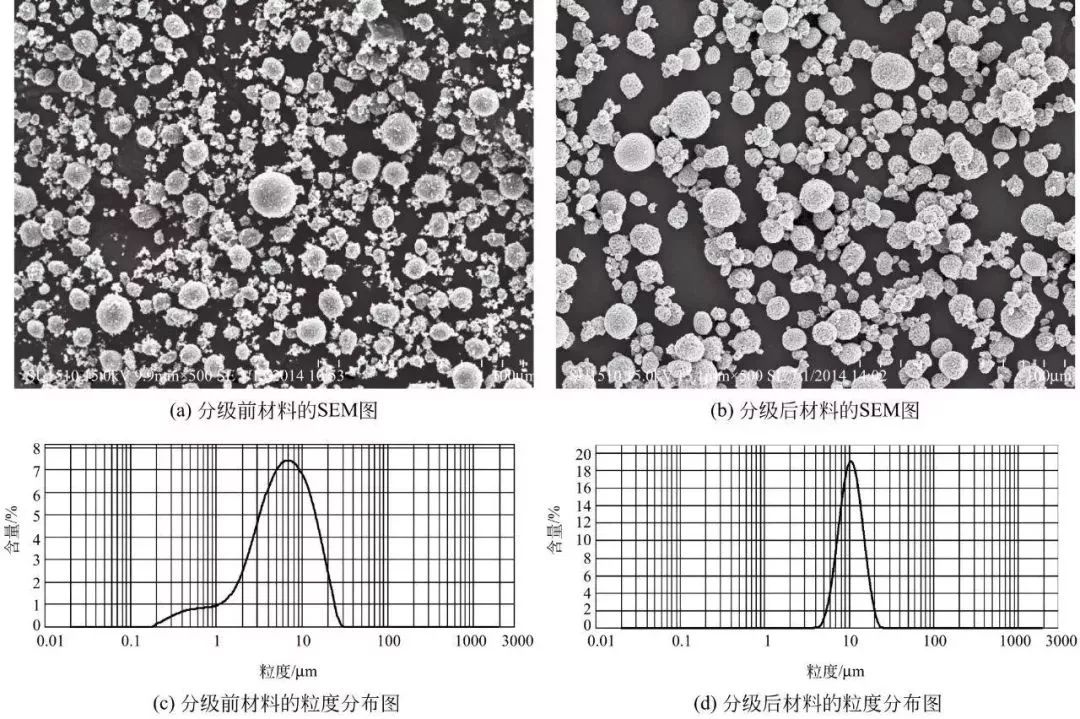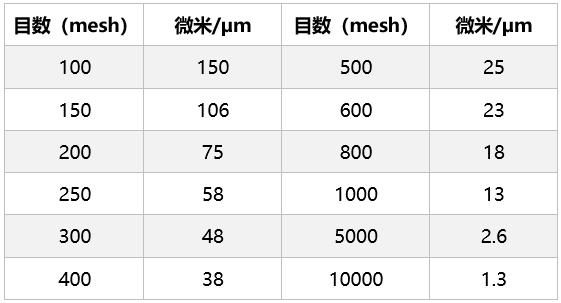With the newly completed production capacity being gradually completed and put into production, in recent years, the power battery using ternary lithium as a positive electrode has largely replaced a power battery that used lithium iron phosphate as a positive electrode in the past.
The three major links in the production of ternary materials are mixed abrasives, high-temperature sintering, crushing and decomposition. The control of each link and the performance of the equipment will have a direct or indirect impact on the final product. Among them, grading, screening, and packaging are the last link of ternary materials. Let's understand these links.
01
Grading
The ternary material particle size distribution affects the specific surface area, compaction density, pole piece processing performance, and battery electrical properties of the material. The crushing equipment can only control the particle size of the material, but it cannot control the particle size distribution of the material. To control the particle size distribution of the material, it is necessary to use a grading apparatus. The classification of ternary materials is generally followed by an airflow classifier after the jet mill to directly classify the comminuted product.
According to the particle size distribution requirements of ternary materials, different air classifiers and grading processes can be selected.

Comparison of product SEM and particle size before and after classification
It can be seen from the particle size distribution that the particle size distribution of the product after classification is much narrower than the particle size distribution of the product before classification. It can be seen from the particle size distribution diagram that some particles with very small particle size have been separated out.
02
Screening
In order to avoid foreign matter or coarse particles in the material, the ternary material must also be sieved. The Dmax of a ternary material is at least less than 50 μm, but sometimes Dmax is exceeded. as the picture shows.

SEM image of large particles in ternary materials
Choosing the right mesh can control the Dmax of the material. As can be seen from the table, the ternary material needs to be selected with a 300 mesh or 400 mesh screen.

Number and screen
Common screening machines include fixed grid sieves, cylindrical sieves, vibrating sieves, etc. The commonly used sieves for ternary materials are shakers. Vibrating screens are the most widely used screens in the industry and use sieve vibrations to screen. The number of screen vibrations is 900-3000 times min-1. The amplitude ranges from 0.5 to 12 mm. The smaller the amplitude, the greater the number of vibrations. The sieve tilt angle is between 0 and 40 degrees.
Vibrating screen has high screening efficiency, generally 80%~95%; screening raw material has a wide range of particle sizes, from more than 250mm to 0.1mm or 0.01mm; large output per unit area; easy to adjust, with less screen clogging. This screen requires special gearing and consumes power.
The ultrasonic controller and the vibrating screen are organically combined together, that is, the ultrasonic vibrating screen. A high-frequency and low-amplitude ultrasonic vibration wave is superimposed on the screen surface, and the powder receives a huge ultrasonic acceleration, so that the material on the screen surface is always in suspension. In order to inhibit sticking, friction, flat drop, wedging and other blocking factors, the performance is better than the shaker.

Ultrasonic shaker
Ultrasonic vibrating screen features: self-cleaning function, mesh is not easy to plug; no need to add bouncing ball and other anti-blocking network device to prevent pollution, so that the screen life extension; screening accuracy is high, suitable for 40 ~ 635 mesh, In particular, particles below 100 mesh are sieved.
For the entire work of the shaker, the most important components are the screens, motors and bearings. In the use of ternary materials, the choice of screen is critical. Because the ternary material processing process should avoid the introduction of iron impurities or other metals, so the screen material needs to choose non-metallic materials, and alkali corrosion resistance.
03
package
The ternary material package is generally vacuum packed or vacuumed and then filled with inert gas.
There are many varieties of vacuum packaging machines, usually divided into mechanical extrusion, intubation, chamber conveyor belt, rotary table and thermoforming. The following is a brief introduction of mechanically-squeezed vacuum packaging machines, intubation vacuum packaging machines and chamber-type vacuum packaging machines.
The principle of mechanically-squeezed vacuum packaging is: after the packaging bag is filled, the air in the bag is removed on both sides with elastic articles such as sponges, and then sealed. This method is the simplest, but it has a low degree of vacuum and is used in applications where the degree of vacuum is not demanding.
The most important feature of intubation vacuum packaging machine is that there is no vacuum chamber. During operation, the packaging bag is put on the suction pipe, and the plastic bag is directly evacuated or pumped--inflated. This model saves the vacuum chamber greatly simplified structure, small size, light weight, low cost, low failure rate; high production efficiency, on average, 2 to 3 times higher than the indoor vacuum packaging machine; the disadvantage is that the product vacuum is lower than the indoor vacuum Packing Machine.
The indoor vacuum packaging machine is available in the form of a desktop, single-chamber and dual-chamber type. Its basic structure is the same and consists of a vacuum chamber, a vacuum/inflation system and a heat sealing device. The vacuum/inflation system consists of a set of solenoid valves and a vacuum pump. Each valve is controlled by the controller to open and close, and vacuum-inflate-heat seal operation or vacuum-heat seal operation is automatically performed.
Chamber vacuum packaging machine features: compact structure, beautiful appearance, easy installation; high vacuum; need to manually put bags, bags, so the productivity is not very high, which is lower desktop and single room, double room to slightly higher.
There is a wide variety of vacuum packaging machines. When choosing a vacuum packaging machine, due to the different packaging sizes of various users, different levels of technical requirements for vacuum packaging, different requirements for work efficiency, should be based on the characteristics of the user's own products, the size of the packaging bag and so on. The basis for the user to determine the model in addition to the sealing length of the packaging machine, double row spacing. The maximum available height of the vacuum chamber, etc., should also consider the following factors:
Packaging speed: For the sake of improving the production efficiency, a two-chamber or multi-chamber vacuum packaging machine can be used to improve the overall production progress.
Vacuum pump: It is the most important component in the vacuum packaging machine. The quality of the vacuum pump directly affects the packaging effect of the vacuum packaging machine.
Packaging machine material: There are now cold-painted cabinets and stainless steel cabinets. The best vacuum machine packaging machine is 304 stainless steel.
Vacuum degree: The packaging material used for vacuum packaging is plastic composite film or plastic aluminum foil composite film, such as polyester/polyethylene, polyester/polypropylene, nylon/polyethylene and so on.
Perkins 201-400KW Diesel Generator
201-400KW Diesel Generator,Perkins Soundproof Generator,Perkins Super Silent Type Diesel Generator,Perkins Super Silent Power Generator
Shanghai Kosta Electric Co., Ltd. , https://www.generatorkosta.com